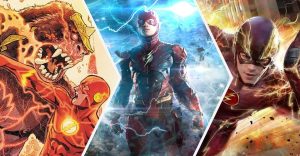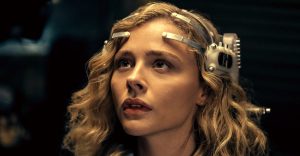The Matrix Resurrections Easter Eggs: Every Reference Explained
Warning! Spoilers Ahead for The Matrix: Resurrections
Here’s (almost) every reference and easter egg sprinkled throughout The Matrix: Resurrections. The latest sequel/reboot in the explosively popular franchise is a testament to its core legacy, as it makes bold choices and commits to a love story with no holds barred. The narrative continues to expand the world established in The Matrix trilogy while shifting the focus of the tale and subverting expectations in a way that is meta and meaningful at the same time.
Resurrections opens with Neo, who once again identifies with his Machine-given name, Thomas Anderson, and who in his immediate reality is a world-famous video game developer of The Matrix franchise. While Neo does not explicitly realize that his games are a fictional rendition of his actual memories, he does subconsciously come to the conclusion that something is amiss. Meanwhile, redpill renegade Bugs and a modal Morpheus attempt to free Neo from the noise of the matrix, risking everything they had fought for over the years in order to save Neo, who they believe is the One.
In terms of narrative and tone, Resurrections is extremely self-referential and self-aware, to the point that it dares to mock its own legacy and make a quip at its parent company. Hence, most of the callbacks and references function on a meta-level, while others are meant to drive a point home, cementing the foundation of major character choices. Here’s a run-down of major easter eggs in Resurrections, along with the seminal references to the rest of the franchise.
Click here to watch The Matrix Resurrections: 25 Things you Missed on YouTube
The Opening Sequence

The opening sequence of Resurrections has been crafted in a way that mirrors the original while diverting significantly from it at the same time. The title card features the telltale trickle of code, but the direction of the same is upwards, signifying the theme of resurrection or rebellion. In terms of mirroring, the opening conversation between the members of the Mnemosyne is meant to mirror that of the members of the Nebuchadnezzar in The Matrix, wherein both parties are in search of Neo. Then on, the Trinity action scene in The Heart O’ The City Hotel is recreated, only for it to go off-script to convey the truth about Neo’s modal, which is built using old code. Some of the dialogue has also been recreated, such as modal Morpheus mirroring Smith’s words: “your men are already dead.”
Root of All Evil / Sense8 / Bound

During the opening sequence in which Bugs is chased by the Agents, a movie named Root of All Evil seems to be playing in the theatres. As Resurrections take constant jabs at the capitalist exploitation inherent within grand, empty franchise expansions that are clearly meant to be cash grabs, the choice of this title is significant, as money is most usually associated with being the root of all evil. However, the true easter egg in this scene is the fact that the film stars Lito Rodriguez, a clear reference to the protagonist in the first two seasons in Sense8, created by the Wachowskis. Resurrections is filled with Sense8 cameos, from some being a part of Deus Machina’s marketing team to members of the resistance aboard the Mnemosyne. There’s also a quick reference to the Wachowskis’ 1996 film Bound, featuring Corky, an ex-con who gets involved in a torrid love affair with Violet, the mistress of a gangster.
Fortnite/Game Awards

In the scene in which everyone in Neo’s office is proceeding towards evacuation, a member of his team appears, played by none other than Donald Mustard, the chief creative officer of Fortnite developer, Epic Games. This is not only a fun cameo but also a nod to the close collaboration between the franchise and Epic Games, who recently helped launch the trailblazing The Matrix Awakens, an interactive tech demo. Apart from this, there’s also a nod to The Game Awards, as one of the trophies in Thomas’ office shows The Matrix winning Game of the Year in the year 1999.
Symbolism: Project MK Ultra/Alice in Wonderland

References to Alice in Wonderland have been rampant in the original The Matrix, from Morpheus referring to Neo as Alice and asking him whether he wishes to go deeper down the rabbit hole. Resurrections continues this trope, from Bugs’ white rabbit tattoo to Sati reading Lewis Carroll’s book in her cafe. The symbolism is carried forward in the way in which reality hopping is possible, as the mirrors acting as portals refer directly to Through The Looking Glass, and “The White Rabbit” by Jefferson Airplane plays over to convey the tiresome loop of the matrix. A subtle symbolism is the framed blue monarch butterfly in The Analyst’s office, a symbol of mind control, brainwashing, and dissociation, as employed in CIA’s notorious Project MK Ultra. Also, the wallpaper behind Neo is also a maze, signifying his status as a lost Alice in the labyrinth of the matrix, while his handler, Jude, makes sure he remains complacent (blue pilled).
Subtle References To The Trilogy

There are several scenes that are intended to either mirror or subvert sequences or characters from the trilogy. One such small detail is the noodle place mentioned by Neo in The Matrix, which is mirrored in the small noodle place Neo frequents in Resurrections, owned by Sati. The noodle place also features a quote from Don DeLillo’s Americana: “It is easier to bury reality than to dispose of dreams.” This, of course, is meant to be a social commentary, along with an overview of Neo and Trinity’s fate. Although their memories are repressed, burying reality for the moment, it is near impossible to get rid of the dream to be more, the yearning to feel whole by taking back agency in one’s life. Apart from this, Neo gorging on a steak during the “White Rabbit” sequence is a nod to Cypher in The Matrix, who talked about the comforts of the matrix, and how it succeeded in keeping the best minds trapped in a loop of suffering under the guise of luxury and the promise of happiness.
John Wick/Chad

More of a meta-reference than an easter egg, Tiffany’s husband in the matrix, Chad, is played by Chad Stahelski, who helmed the John Wick franchise, also starring Keanu Reeves. The rabbit hole goes deeper, as Stahelski was Reeves’ stunt double in The Matrix trilogy, serving a neat connection to the franchise as a whole.
The Concept of Binaries

The concept of binaries is central to the fabric of The Matrix, be it in the form of gender identity, literal binary code, or the interaction between two antithetical elements, such as the humans and the machines. Resurrections asks audiences to look into the space that exists between binaries, evidenced by the fraught and complicated relationship between Neo and Smith, who eventually find unlikely allies in one another for a brief while. This is reflected via visual and narrative cues as well, such as the name of Neo’s latest game and the human habitation of IO, which omits the entry points in the words ZION, symbolizing the symbiotic relationship between humans and synthients. The greatest example of binaries is the way in which the concept of the One is approached – Neo and Trinity are able to overcome systemic manipulation and merge as one in The Matrix Resurrections, allowing them to share the powers traditionally attributed to the “anomaly of anomalies” within the matrix.
About The Author


















